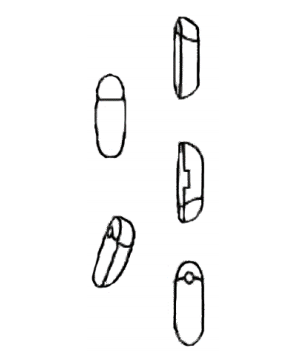September 27, 2021
A proposed trade mark must have distinctive character to be registrable[1], meaning that it must enable the product to which it relates to be identified as originating from a particular undertaking and thus enable that product to be distinguished from those of other undertakings[2].
On 14 July 2021, the European Union General Court handed down a decision[3] which, overturning the earlier decision of the EUIPO Board of Appeal, which had upheld the examiner’s decision, held that the shape of a lipstick case did have distinctive character and was therefore registrable by French cosmetics brand, Guerlain[4].
The decision provides useful guidance as to when a shape will be considered distinctive and will be welcome to many industries, including cosmetics and fashion.
Background
In 2018, Guerlain applied to the EUIPO to register a 3D mark for the shape of a lipstick case as shown below.

The EUIPO Examiner, upheld by the Board of Appeal, dismissed the application for lacking distinctive character, on the basis that the lipstick case did not “depart significantly from the norm and customs of the sector”.
The General Court Decision
In contrast to the earlier decisions, the General Court held that the lipstick case did have distinctive character, because it departed significantly from the norm and customs of the lipstick sector
In making its decision, the Court provided the following commentary:
- The distinctive character assessment is “not based on the originality or the lack of use of the mark in the field to which the goods and services concerned belong,” and as such, “mere novelty of [a] shape is not sufficient to conclude that there is distinctiveness.”
- However, “the fact that a sector is characterized by a wide variety of product shapes does not mean that a new possible shape will necessarily be perceived as one of them.”
- A “high-quality design” of goods does not necessarily mean that the shape of those goods makes it possible to distinguish them from products of other undertakings.
- The consideration of the aesthetics of a shape is not related to its attractiveness, but to whether the product is capable of “generating an objective and uncommon visual effect in the perception of the relevant public”.
The court found that the proposed mark had distinctive character and was “uncommon for a lipstick and differs from any other shape existing on the market”. In making its decision, the Court noted:
- The shape of the proposed mark, which it stated was “reminiscent of that of a boat hull or a baby carriage”, and differed significantly from the images considered by the Board of Appeal which were largely of cylindrical and parallelepiped lipsticks.
- The small oval embossed shape on its surface which it said was unusual and “contributes to the uncommon appearance” of the proposed mark.
- The fact that the lipstick could not be placed upright, which reinforced the uncommon visual appearance of its shape.
The Court concluded that “the relevant public will be surprised by this easily memorable shape” and “will perceive it as departing significantly from the norm and customs of the lipstick sector and capable of indicating the origin of the goods concerned”, such that it had distinctive character and was registrable.
Comment
The Court’s finding departs from a growing number of decisions where iconic shapes have fallen foul of the distinctive character requirement, including the shape of Land Rover Defender cars[1], London taxis[2] and Viennetta ice cream[3].
Although the distinctive character requirement is no different for shape marks than for more traditional word marks (and is to be applied no more strictly), it has proven a difficult hurdle for shape marks to overcome on the basis that consumers are more likely to associate a word mark with a product’s origin than shape alone. This case perhaps marks an easing of the burden.
This decision should provide encouragement to brand owners that where a shape meets the trade mark criteria of inherent distinctiveness, and, crucially, when it does depart significantly from others in its sector, it may succeed in registration as a trade mark.
[1] Article 7(1)(b) EUTMR
[2] Linde AG (and others) v Deutsches Patent-und Markenamt, Joined Cases C-53/01 to C-55/01
[3] The full decision is currently only available in French. The press release, available in English is here: https://curia.europa.eu/jcms/upload/docs/application/pdf/2021-07/cp210126en.pdf
[4] Case T-488/20 Guerlain v EUIPO
[5] Jaguar Land Rover Limited v Ineos Industries Holdings Limited [2020] EWHC 2130 (Ch)
[6] London Taxi Corporation Limited v Frazer-Nash Research Limited and Ecotive Limited [2017] EWCA Civ 1729
[7] Unilever Plc’s Trade Mark Application [2003] RPC 651